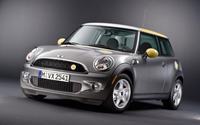Mini E Exclusive - First Drive Satisfying
First results of Mini E pilot prove to be satisfying
By Henny Hemmes
Senior European Editor
The Auto Channel
MUNICH, January 5, 2010; Last month, during the exclusive preview of the Active E Concept , BMW also presented the outcome of the first results with the electric Mini E in Berlin. The trendy Mini-division had the premiere of bringing on the road the first electrified model that has been developed under Project-i, known within the BMW Group as the Megacity car.
The Mini E was unveiled in November 2008 at the 2008 LA Auto Show and since spring 2009, more than 600 units hit the roads for a year long pilot in California, New York, New Jersey, Berlin, London and Munich.
BMW is aware that this first electric model has its shortcomings, such as the lack of rear seats. Their space has been taken by the huge package of 48 modules with in total 5,088 lithium-ion cells.
But the tests with the Mini E are important for the evolution of the upcoming electric model, that is due to arrive before 2015. BMW did not only gather data from the car and the first group of Berlin test drivers, but also interviewed the men and women who drove on the streets of Berlin for six months.
Last month, the results of the first part of the Berlin test were presented by Dr. Klaus Draeger, member of the board of BMW AG and responsible for research and development.
Dr. Draeger said that the results are a confirmation of BMW’s expectations on the use of the electric car in a big city. The average daily distance proved to be much less than the average range of the Mini E of 93 miles.
“We dismissed a range under 62 miles, we would prefer 124 miles and thank that 155 miles (under optimal circumstances in the test cycle) is ideal. The average range of 155 mi. of the Mini E proved to be sufficient.
Statistics say that in Berlin people who drive a BMW 116i cover an average distance of 26 mi. per day, those with a Mini Cooper travel 27 mi per day.
The average of the electric Mini is 23.5 mi. per day. That is even somewhat higher than the German average of 22.4 mi. in 2008. Another known fact is that in that year 98 per cent of an daily run is less than 93 miles.
The test drivers used their Mini E for 80 per cent of their runs, but 90 per cent preferred four seats and more luggage space. The sporty feel was appreciated by all test drivers, mainly 35 year old males with a higher education. The electric Mini is sporty indeed, with 150 kW(204 hp) and a maximum torque of 162 lb-ft. it outperforms the Cooper with 8.5 seconds for the sprint from 0-60 mph.
The Berlin Mini’s were charged once in every three days for about 5 hours, but mostly the charging time was 2 hours. The drivers prefer charging at home or at work, and also favour loading during a visit to the shopping mall.
The German test was not performed yet under wintry conditions, but test drivers based in New York and New Jersey already experienced the problem of the batteries being much less efficient when temperatures drop below the freezing point. A fact that is known from tests with hybrid vehicles in arctic areas.
“By 2015 we will not be building a slew of EVs, but we want to be prepared to bring such a car on the road, to show that we are in focus a s manufacturer who knows how to build a good electric car that also meets the expectations of BMW customers,” Dr. Draeger said. “But we also need efficient combustion engines in conventional cars. That is why we will proceed with the development of our EfficientDynamics technology that now is implemented into every model of the range.”
Upon our question if BMW is considering to cancel the test program with the 7-Series Hydrogen cars, he said: “For some time to come, we will stick to the 7-Series, as hydrogen and its infrastructure still have a long way to go.



